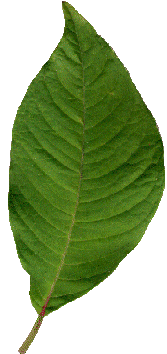
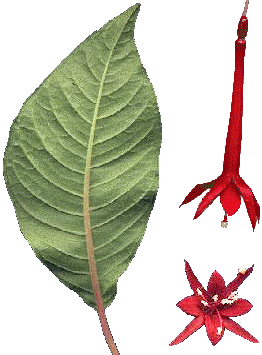
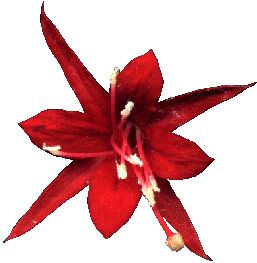
Een botanische fuchsia... One of the species...



Fuchsia boliviana is misschien wel de meest algemeen voorkomende botanische fuchsia in zijn verspreidingsgebied. Er zijn verschillende soorten wilde fuchsia's die op de rand van uitsterving leven, maar met deze is dat niet het geval. De oorsprong ligt waarschijnlijk in de nevelwouden van de Andes, in Bolivia en Zuid-Peru tot in het noorden van Argentinië. De verspreiding is nu veel groter.
De struik moet al door de Inca's in cultuur zijn gebracht vanwege de eetbare bessen en misschien ook wel de fraaie bloemen. Door deze vroege cultivering is het een species die in velerlei variaties voorkomt; de bessen kunnen vrij rond zijn zoals die van mijn plant, maar vaak zijn ze langwerpiger; vooral bij F. boliviana alba, met witte buis en lichtrose kelkbladen, gaat de vergelijking met "komkommertjes" op, omdat de vruchten groen blijven.
Ook de bloemen vertonen verschillen in vorm en kleur - er zijn er met een lange buis, zoals die van mij, maar er schijnen ook Boliviana's te zijn met kortere bloemen; qua kleur zijn er voor buis en kelk mogelijkheden van donkerrood tot wit en alles wat daartussen ligt. De kroonbladeren zijn wel altijd rood of rose, nooit wit.
De plant die ik heb, is een zaailing van onbekende afkomst. Hij groeide rond 1987 als onkruid in een kas waar o.a. fuchsia's werden gekweekt, niet eens door de beheerder herkend als een fuchsia.
Ik zag wel aan de bouw van de wat grove zaailing met zacht lichtgroen blad met een lila-glans in de top, dat hij tot dit geslacht behoorde en mocht 'm wel meenemen. Zelf weet ik ook pas sinds een paar jaar, dat het Fuchsia boliviana betreft.
Aanvankelijk kreeg ik de plant bijna nooit in bloei, want 's winters kuilde ik 'm in en in het voorjaar liep hij weer uit maar er kwam nooit een knopaanleg. Totdat ik in een nieuwere versie dan de mijne van het boek "Fuchsia's hebben en houden" las over First Success, een plant die alleen in het vroege voorjaar bloeit en 's winters niet afgesnoeid mag worden omdat de knopaanleg begint rond de kortste dag. Het kwam bij me op, dat dit ook weleens het geval kon zijn met mijn onbekende fuchsia, waarin ik ooit 's winters op de slaapkamer eens een verdwaald lang rood bloempje had gezien, toen de plant nog te jong was om in te kuilen.
Inderdaad - ik kuil hem sindsdien niet meer in, houd 'm metveel moeite 's winters een beetje aan de groei (tegengewerkt door talloze bladluizen), en in het voorjaar verschijnen er nu knoppen. Zowel in 1998 als 2000 heb ik de plant in bloei gehad, maar met slechts een paar bloemtrossen en niet zulke grote als hij in betere omstandigheden zou kunnen hebben. Het mij ontbreken van een kas speelt me beslist parten bij het overwinteren van deze grote struik, die op zijn laatst eind september mag worden gesnoeid omdat anders, zoals mij bleek in 1999, de kans op knopaanleg alweer verkeken is.
Fuchsia boliviana probably is the most commonly occurring fuchsia species in its original habitat. There are several wild fuchsias that live on the border of extinction, but not this one. Its origin probably lies in the misty mountainforests of the Andes, in Bolivia and South Peru, extending to North Argentina. It's far more widely spread nowadays.
The bush already was cultivated by the Incas, because of its edible fruits and maybe also its lovely flowers. Because of this early cultivation, the species occurs in many variations; the berries may be quite round like those on my plant, but often they're more oblong, and if the flowertube is white and the sepals light pink as is the case with F. boliviana alba the fruits may look like little "cucumbers", because they remain green when ripe.
Also the flowers vary in shape and colour - mostly the tube is long and slender, like in my plant, but there must be shorter-tubed flowers as well; the colour of tube and sepals varies from dark-red to white, and the petals are red or pink (not white).
The plant I have is a seedling of unknown origin. Around 1987, it grew as a weed in a greenhouse where a.o. fuchsias were cultivated. The gardener taking care of the greenhouse didn't even recognize the plant as a fuchsia, but I saw the unknown seedling with the soft large lightgreen leaves, a bit purplish in the growing-point, as a member of the genus, and was allowed to take it with me. But that it's a Fuchsia boliviana I didn't know till a few years ago.
During the first 10 years I hardly ever got any flowers in the plant; only in the beginning, when it was still too young to be cut off and put under peat-litter during the winter, it bore one or two long red flowers in the bedroom.
One day I read in a fuchsia-book about a plant called First Success, that only flowers in spring and therefore shouldn't be pruned in winter because bud initiation takes place around the shortest day.
I thought this might be the case with my unknown species too, and decided not to cut it off this time. Indeed, in 1998 it bore these bunches of red flowers, only a few - because the lack of a greenhouse makes overwintering not easy for such a big bush, about 2 m high, moreover having to cope with thousands of green aphids inside the house.
Pruning after the end of September is fatal for the flowering season the next year - as I experienced in 1999.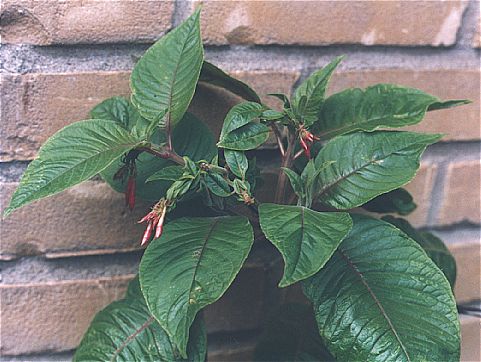
Knopaanleg in het vroege voorjaar The beginning of the flowers, early in spring
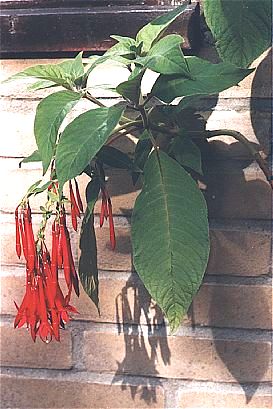
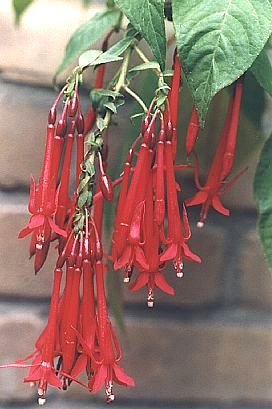
Een forse struik met véél bloemen en bessen aan lange zware trossen
A sturdy bush with an abundance of flowers and berries in long heavy bunches
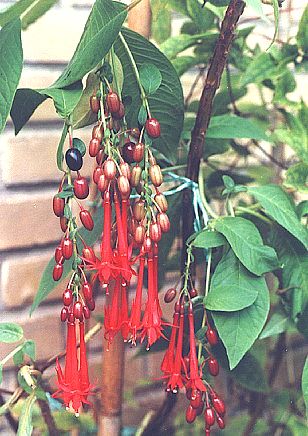
Zie hier nog enige scans van de vruchten, ook de binnenkant, + beschrijving
Click here for some scans of the fruits, also the inside, + description

